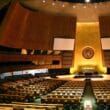The ban treaty: An interim step, but politically profound
By Joelien Pretorius, December 14, 2016
It is time for the next big building block in the process toward universal denuclearization—a treaty that outlaws nuclear weapons.
The first major building block in the effort to establish and maintain a world without nuclear weapons was the Nuclear Non-Proliferation Treaty (NPT), which entered into force in 1970. A third building block would be a nuclear weapons convention outlining the timelines, technicalities, and verification mechanisms involved in eliminating nuclear weapons.
This gives an idea what the ban treaty—the second of three major building blocks—would contain, and why it is necessary. But why is now the time?
One answer is that many non-nuclear weapon states have grown impatient with disarmament’s slow pace. But the current nationalist turn in global politics—as reflected in the United Kingdom’s vote to exit the European Union and the election of Donald Trump as US president—has provided fresh urgency to the ban treaty initiative. Today, the nuclear taboo that has developed since atom bombs were used against Japan in 1945 seems under threat.
The nuclear taboo prevents nuclear weapons from being used; non-use in turn reinforces the taboo. Indeed, a norm such as the taboo evolves over time as some action, informed by ideas of what is appropriate, right, moral, and sensible, is or is not performed. Each time nuclear weapons could conceivably be used in conflict but, because using them is deemed an inappropriate response to a situation and contradictory to the values of a society (whether domestic or international), the taboo strengthens. In today’s nationalist environment, careless statements could reignite in imaginations the notion that nuclear weapons are usable.
The ban treaty should elevate the nuclear taboo to the level of an absolute—using a nuclear weapon must become unthinkable. The ban must close the loophole left by the International Court of Justice in 1996 when it ruled on the legality of using nuclear weapons. The Court determined that it could not “conclude definitively whether the threat or use of nuclear weapons would be lawful or unlawful in an extreme circumstance of self-defence, in which the very survival of a state would be at stake.” The ban must make it clear that there can be no situation conceivable that justifies use of nuclear weapons or even the threat of their use. As such, the ban is an instrument to reach an endgame in which non-use of nuclear weapons becomes what in law is termed jus cogens—a peremptory norm or compelling law that is simply assumed, and that cannot be derogated from—by anyone, ever.
But considering specific cases of human conduct (such as nuclear weapon use) through the lens of jus cogens requires political work. The nuclear taboo, to be peremptory, must be accepted and recognized as peremptory by the international community at large. The ban treaty, then, is an instrument to disrupt the comfort of those who still believe that deterrence logic (or mutual assured destruction) provides a security rationale for nuclear weapons. In place of deterrence logic, the ban establishes the notion that security is found in the logic of mutual assured abstinence from the nuclear option.
Odious creatures. A conference to negotiate a ban treaty is imminent because of the combined political work that states and non-state actors have already performed; this political work is known as the humanitarian initiative. The humanitarian initiative has shifted the focus of nuclear prohibition from actors to technology. The NPT, despite its tremendous success in containing nuclear weapons, focuses on actors—those with and those without nuclear weapons. Under the treaty, all states are obliged to negotiate general and complete disarmament in good faith, but no deadline for such negotiations is stipulated. This legal gap has been disingenuously used as a means for allowing nuclear weapons to stay in the “right” hands and for keeping them out of the “wrong” hands. A ban treaty, on the other hand, would deem all nuclear weapons inhumane. Even in perceived “good” hands, they would still be illegitimate.
A ban treaty can function at a normative level to stigmatize nuclear weapons for everyone and therefore stigmatize nations that retain these weapons—even if they haven’t signed on to the ban treaty. In the public eye, states that possess nuclear weapons must come to be seen (and their defenders must come to feel) like Gollum, the odious creature in J.R.R. Tolkien’s book The Lord of the Rings, who says: “We wants it, we needs it. Must have the precious.” The ban will be an important legal instrument to be sure, but more than that, it will be a political instrument around which activists—whether states, individuals, or civil society—can do further political work to create the common sense that possessing nuclear weapons is immoral and irrational.
Creating reality. So what should a ban treaty actually include? One clue comes from the experience of my own nation of South Africa, which once had nuclear weapons but gave them up. South Africa took the moral high ground when it denuclearized in 1990, and any other nuclear-armed state that became nuclear-free would do the same. Giving up nuclear weapons is an achievement to be celebrated by the international community, and a ban treaty should include positive language to entice denuclearization.
In addition, the ban treaty might declare in its preamble that member states are “eager to see possessor states lead in the effort to attain and maintain a world without nuclear weapons by initiating negotiations on a nuclear weapons convention.” A further declaration might recognize “a special role for the permanent members of the United Nations Security Council, the organization primarily responsible for international peace and security, in leading denuclearization by example.”
The treaty should not be crowded with too much detail. Nor should new institutions be created at this point—that would be the prerogative of a convention. Much of the verification work associated with the ban can be subsumed under existing structures such as the International Atomic Energy Agency.
As an interim measure toward a nuclear weapons convention, the ban itself should be an easy but big step. It can speed up disarmament. But it is not a direct instrument to force nuclear-armed nations to disarm. Rather, it is an element of a long-term project to construct a reality in which nuclear weapons have no place and nuclear-armed nations themselves come to see reality in that light.
Topics: Nuclear Weapons
Share: [addthis tool="addthis_inline_share_toolbox"]














